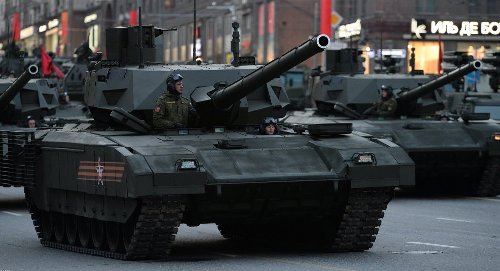Discover the power of the new 'monster' of super-T-14 Armata
Russia's T-14 Armata supercar has increasingly revealed its powerful "monster" with the most advanced new equipment, outstanding as a material made of special steel that can work well in everything. weather conditions.
The new "monster" power of T-14 Armata super tank
According to the Russian Steel Materials Research Institute, the T-14 Armata super tank is made of special steel, which can work well in all weather conditions. According to the source, the main protective armor of the T-14 Armata tank was built with a new steel codenamed 44S-SV-SH with extremely high durability and being able to withstand the temperature environment. extremely low even in the Arctic.
The advantage of the main protective armor of super tank Armata is light weight , thanks to Russian engineers who developed a special steel that is more durable than the steel used before. Even the thickness of a protective armor has decreased by 15% compared to before but still retains its protection against external impacts.

Super T-14 Armata is made of special steel
Besides using this type of steel for super tank Armata, the Russian Army also uses this material to build other military equipment in the future. Russia's Steel Materials Research Institute said the use of new steel alloys in the manufacturing process helped to protect the sustainable structure of this material. Besides, it also optimizes the contact ability of 44S-SV-SH for special temperature environments.
This latest Russian tank, built on Armata armored chassis, was introduced at the parade on the 70th anniversary of Victory in the Great Patriotic War, in the future being equipped with a 152mm cannon. Izvestia newspaper quoted Russian Deputy Defense Minister Dmitry Rogozin, who is in charge of the defense industry complex, said: "We have a steel shell burning 1m thick. It will be equipped for Armata."
At the last parade, T-14 Armata tanks equipped with 125 mm guns . These are the first tanks of the Russian Ministry of Defense. However, it is expected that the next batch of Armata will be equipped with more powerful guns - 152mm.

T-14 Armata super-tank cannon burned a steel shell of 1m thick
It is likely that the increase in Armata's power may take place in the near future because Russian President Vladimir Putin has placed the earliest task to complete the test of the weapons for the infantry presented at the parade. on. The Russian head of state said in a meeting about the development of Russian armed forces : "It is necessary to complete all tests quickly and move to mass production".
Armata is the latest model of Russian military equipment. A special feature of the car is the unmanned turret and armored compartment for the crew separated from the combat combination. This design increases the chances of survival in the tank even if the bullet in the vehicle unfortunately explodes - a higher safety level than the Western tank.
The tank is equipped with an automatic reloading system , the turret is covered by a protection system from all sides. Vehicles using the latest radar system can detect targets at a distance of 100km.
Armata chassis , developed by Uralvagonzavod factory, is a versatile armor chassis that can be used to solve various tasks. On Armata platform, Russia built T-14 tanks and heavy armored vehicles.

Super T-14 Armata tanks are the leading tanks of the Russian Ministry of Defense
Russian military expert Mikhail Timoshenko said the task of the new armor of the super-arm Armata would be to protect the entire body of the tank, internal optoelectronic devices and other equipment installed on the side. outside the tank in front of infantry weapons, artillery shells and anti-tank missiles.
However, if operating in a low temperature environment, the protective armor made of steel materials was often ineffective. If a new steel is used to resist the harshness of low-temperature combat environments this will be changed.
Russia's confidence in the ability of Armata's tanks in the Arctic combat environment is entirely understated because the Soviet Union and Russia had previously had experience in tanks and combat operations in this harsh environment and confirmed the power in World War II.
- Super tank Armata Russia can fight on ... Mars
- The ultimate weapons help Russia erase the Soviet shadow
- Discovering 'super ice monster' destroying alien life
- Top 10 most powerful tanks in the world
- Half-toned femur revealed a prehistoric 'super monster'
- 'Super monster monster' blew away the ocean of 1 planet
- Super typhoon 'monster' Ha Long smashes the strongest storm record in the world
- Super strong, lightweight, cheap, multi-purpose made of paper
- 10 most famous aquatic monsters of all time
- Kraken monster is real?
- German newspaper voted 5 strongest TG weapons: China brought unexpected surprises
- Discover the hiding place of Loch Ness monster monster?
 'Fine laughs' - Scary and painful torture in ancient times
'Fine laughs' - Scary and painful torture in ancient times The sequence of numbers 142857 of the Egyptian pyramids is known as the strangest number in the world - Why?
The sequence of numbers 142857 of the Egyptian pyramids is known as the strangest number in the world - Why? History of the iron
History of the iron What is alum?
What is alum?